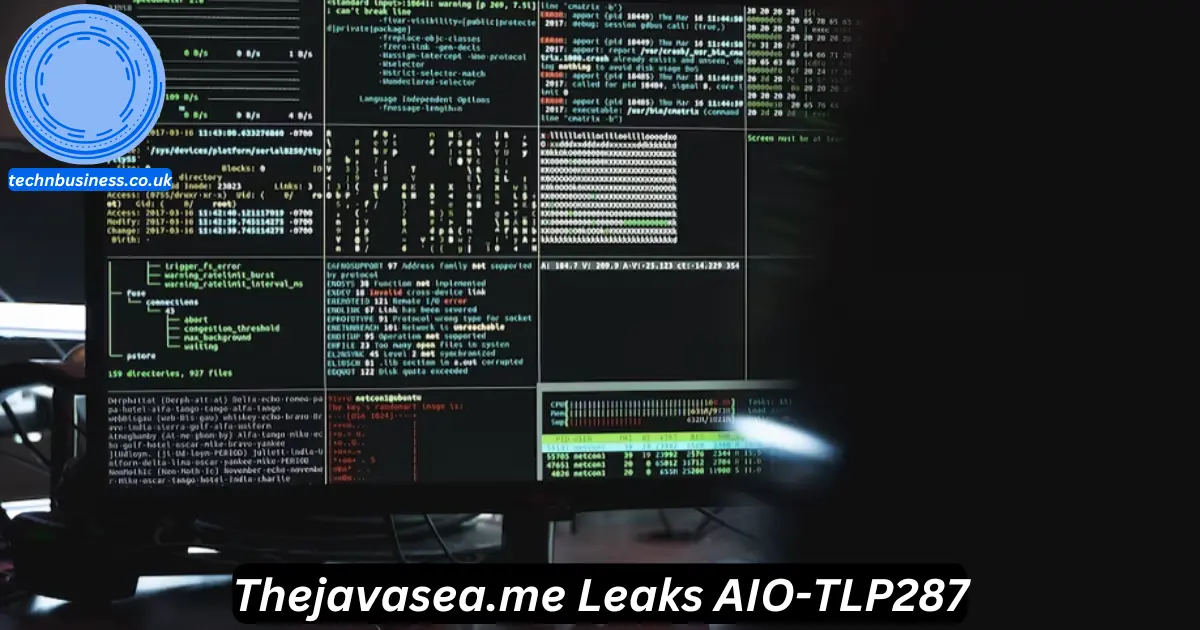In the ever-evolving landscape of cybersecurity, data breaches have become increasingly common, affecting millions of users worldwide. One of the most significant breaches in recent history is the thejavasea.me leaks AIO-TLP287. This thejavasea.me leaks AIO-TLP287 incident exposed vast amounts of sensitive data, raising serious concerns about digital privacy and security.
Thejavasea.me, a platform known for its extensive digital services, found itself at the center of a cybersecurity crisis when a large-scale data leak surfaced. The breach, identified as AIO-TLP287, contained a wealth of compromised data, including personal user information, corporate records, and financial details. This exposure not only impacted individuals but also had severe implications for businesses and organizations reliant on the platform.
This article provides an in-depth examination of the thejavasea.me leaks AIO-TLP287. We will explore the nature of the breach, the extent of the data exposure, the consequences for affected users, and the broader implications for cybersecurity. Additionally, we will discuss proactive measures individuals and organizations can take to mitigate such risks in the future.
Understanding thejavasea.me and the AIO-TLP287 Leak
What is thejavasea.me?
Thejavasea.me is an online platform offering various digital services, tools, and resources. Over time, it has built a reputation for its expansive database, attracting a significant user base seeking information and digital solutions. The platform provides an array of features, including software development tools, cybersecurity insights, and a knowledge-sharing community that caters to both novice users and industry experts.
Given its extensive repository of data, thejavasea.me naturally became a prime target for cybercriminals looking to exploit its vast digital ecosystem. As the user base grew, so did the complexity of the threats facing the platform. From data scraping attempts to targeted phishing campaigns, various malicious activities have attempted to compromise the security of the site. Despite efforts to bolster its defenses, the platform ultimately fell victim to a significant data breach, underscoring the persistent challenges of securing online infrastructures in an era of sophisticated cyber threats.
What is AIO-TLP287?
The term AIO-TLP287 refers to a specific dataset within the thejavasea.me breach. The abbreviation “AIO” commonly stands for “All-In-One,” suggesting a comprehensive compilation of data, while “TLP287” serves as an identifier for this particular dataset. This dataset represents one of the most significant leaks associated with the platform, as it encompasses a broad range of sensitive and personally identifiable information, making it a major concern for cybersecurity experts and affected users alike.
The nature of AIO-TLP287’s exposure underscores the evolving complexity of cyber threats targeting large-scale digital repositories. The dataset was not only vast in scope but also included highly sensitive material, making it an attractive target for malicious actors. Security analysts suggest that such datasets are often exploited for various fraudulent activities, including identity theft, financial fraud, and unauthorized access to corporate networks. The far-reaching consequences of the breach extend beyond immediate financial risks, affecting personal privacy, corporate integrity, and national security considerations.
The contents of AIO-TLP287 included:
- Personal Information: Names, email addresses, phone numbers, and physical addresses.
- Financial Records: Credit card details, banking information, and transaction histories.
- Corporate Data: Confidential business documents, internal communications, and proprietary information.
- Authentication Credentials: Usernames, passwords, and security questions.
The exposure of such an extensive range of data makes this breach particularly concerning, posing significant risks to both individuals and businesses.
The Impact of the AIO-TLP287 Leak
Consequences for Individuals
For individual users, the implications of this data breach are severe and multifaceted, impacting various aspects of their personal and financial security. The exposure of sensitive data can have immediate and long-term consequences, leading to a heightened risk of cybercrime, financial fraud, and identity theft. Victims may find themselves dealing with unauthorized transactions, compromised online accounts, and even reputational damage as a result of their personal information being leaked.
Moreover, the emotional toll of such breaches cannot be overlooked. Many individuals experience heightened stress and anxiety, knowing that their data is circulating in illicit markets, potentially being exploited for malicious purposes. Restoring security and confidence in digital interactions can be a lengthy and challenging process, requiring users to take extensive measures such as changing passwords, freezing credit reports, and constantly monitoring their accounts for suspicious activities.
Some of the most critical consequences include:
- Identity Theft: Exposed personal information can be used by cybercriminals to impersonate individuals, commit fraud, or gain unauthorized access to accounts.
- Financial Loss: Leaked financial details have led to unauthorized transactions, fraudulent purchases, and banking fraud.
- Privacy Invasion: Sensitive personal details being publicly accessible increases the risk of harassment, blackmail, and other forms of exploitation.
- Credential Stuffing Attacks: Since many users reuse passwords across multiple platforms, leaked credentials can be exploited to access other accounts.
Repercussions for Businesses
Organizations affected by the breach face both financial and reputational damage, including:
- Loss of Customer Trust: Consumers are less likely to trust a platform that has failed to secure their data.
- Legal and Regulatory Penalties: Many businesses must comply with data protection laws, such as GDPR and CCPA. Failure to protect customer data can result in hefty fines.
- Intellectual Property Theft: Leaked corporate data can include proprietary information, trade secrets, and internal strategies, leading to competitive disadvantages.
- Operational Disruptions: Companies must allocate significant resources to mitigate the damage, conduct security audits, and implement new security measures.
Broader Cybersecurity Implications
The AIO-TLP287 leak highlights several cybersecurity concerns that extend beyond the affected platform:
- Growing Sophistication of Cyber Attacks: Hackers are continuously evolving their techniques, requiring organizations to adopt more advanced security measures.
- Insider Threats: Some data breaches are facilitated by insiders with access to sensitive data, emphasizing the need for strict access controls.
- Need for Proactive Security Measures: Regulatory bodies and industry leaders must push for stronger cybersecurity frameworks to prevent future breaches.
How the Breach Occurred
Although the exact method used in the AIO-TLP287 breach remains under investigation, several common vulnerabilities could have contributed to the incident:
- Unpatched Software: Cybercriminals often exploit outdated software with known security flaws.
- Weak Password Policies: Poor password management can make it easier for attackers to gain access.
- Phishing Attacks: Employees or users falling victim to phishing scams may have inadvertently given attackers access.
- Lack of Multi-Factor Authentication (MFA): Without MFA, even compromised credentials can lead to unauthorized access.
- Poor Data Encryption: Weak or absent encryption methods can make stolen data easier to exploit.
Lessons Learned and Preventive Measures
For Individuals
To protect personal data and minimize the impact of data breaches, individuals should adopt the following best practices:
- Use Strong, Unique Passwords: Avoid reusing passwords across multiple accounts and use password managers to store complex passwords securely.
- Enable Two-Factor Authentication (2FA): Adding an extra layer of security can prevent unauthorized access even if credentials are compromised.
- Monitor Financial Statements: Regularly review bank and credit card statements for suspicious transactions.
- Stay Informed: Keep up with the latest cybersecurity trends and be cautious of phishing emails and other online scams.
For Organizations
Businesses must take a proactive approach to cybersecurity by implementing the following measures:
- Conduct Regular Security Audits: Routine vulnerability assessments can help identify weaknesses before they are exploited.
- Implement Strict Access Controls: Limit data access to only those who need it and enforce role-based access restrictions.
- Train Employees on Cybersecurity Best Practices: Awareness programs can help staff recognize potential threats and avoid falling victim to social engineering attacks.
- Invest in Advanced Security Solutions: Utilize intrusion detection systems, firewalls, and AI-driven threat analysis tools.
- Encrypt Sensitive Data: Encryption adds an additional layer of protection, making data unreadable to unauthorized users.
Future Outlook: Strengthening Cybersecurity in a Digital Age
As cyber threats continue to evolve, it is crucial for both individuals and businesses to remain vigilant and proactive in their cybersecurity efforts. Cybercriminals are becoming more sophisticated, employing advanced techniques such as artificial intelligence-driven attacks, ransomware-as-a-service, and deepfake technology to exploit vulnerabilities in digital systems. This ongoing escalation in cyber threats necessitates a continuous effort to stay ahead with updated security protocols and comprehensive cybersecurity strategies.
Governments and regulatory bodies are also stepping up their efforts to enhance data protection laws and enforce stricter security standards. Policies like the General Data Protection Regulation (GDPR) in Europe and the California Consumer Privacy Act (CCPA) in the United States have set new benchmarks for data security, holding companies accountable for breaches and ensuring consumer rights are protected. Additionally, international collaborations and cybersecurity task forces are being formed to combat global cyber threats, reinforcing the need for a unified and proactive approach to cybersecurity in an increasingly interconnected world.
The Role of Governments and Regulations
- Stricter Data Protection Laws: Regulations such as GDPR in Europe and CCPA in California are holding companies accountable for user data security.
- Cybersecurity Awareness Campaigns: Governments are launching initiatives to educate citizens about online safety.
- Support for Cybersecurity Research: Increased investment in cybersecurity innovation can lead to the development of more robust security solutions.
The Future of Data Protection
- Artificial Intelligence in Cybersecurity: AI and machine learning are being used to detect anomalies and prevent cyberattacks before they happen.
- Blockchain for Secure Transactions: Decentralized and tamper-proof blockchain technology can enhance security in digital transactions.
- Zero-Trust Security Models: Organizations are shifting towards zero-trust frameworks that require continuous authentication and verification.
Read More: FTAsiaStock Technology News: A Deep Dive into the Digital Revolution
Conclusion
The thejavasea.me leaks AIO-TLP287 incident serves as a stark reminder of the risks associated with digital platforms and the importance of robust cybersecurity measures. The breach has had far-reaching consequences, affecting individuals, businesses, and the broader cybersecurity landscape.
By learning from this incident and implementing proactive security strategies, individuals and organizations can better protect themselves against future cyber threats. As technology advances, so must our approach to digital security, ensuring a safer online environment for everyone. Vigilance, education, and investment in cybersecurity are the keys to minimizing the risks associated with data breaches in the digital age.
FAQs
What is thejavasea.me leaks AIO-TLP287?
Thejavasea.me leaks AIO-TLP287 refers to a significant data breach involving the thejavasea.me platform. This breach exposed a large dataset containing sensitive personal, financial, and corporate information, raising major cybersecurity concerns.
How did the AIO-TLP287 breach happen?
While the exact method of the breach is still under investigation, common vulnerabilities such as weak passwords, phishing attacks, unpatched software, and lack of encryption may have contributed to the data leak.
What type of data was leaked in AIO-TLP287?
The breach exposed personal information (names, emails, phone numbers), financial records (credit card details, banking data), corporate documents (confidential business files), and authentication credentials (usernames, passwords).
How can I check if my data was affected by the AIO-TLP287 leak?
Individuals concerned about their data exposure can use online breach-checking services like Have I Been Pwned or monitor cybersecurity news sources for updates regarding compromised accounts.
What steps should I take if my information was exposed?
- Immediately change passwords for all online accounts.
- Enable two-factor authentication (2FA) wherever possible.
- Monitor financial transactions for unauthorized activity.
- Consider freezing your credit to prevent identity theft.
- Stay updated on cybersecurity news to respond to potential threats proactively.
How can businesses prevent such data breaches?
Organizations should implement strict security protocols, conduct regular vulnerability assessments, encrypt sensitive data, educate employees on phishing scams, and invest in advanced cybersecurity tools like AI-driven threat detection and zero-trust security models.
Are there legal consequences for thejavasea.me due to the breach?
Depending on jurisdictional data protection laws such as GDPR and CCPA, thejavasea.me may face legal action, fines, or regulatory penalties for failing to secure user data.











